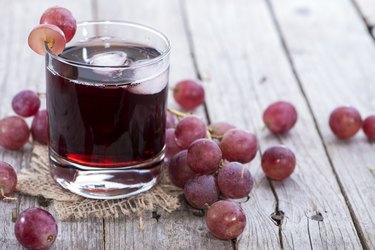
If you like to start your day with a glass of juice, you might want to check the nutrition label to see how much sweet stuff is lingering in your favorite morning beverage. Believe it or not, the sugar in some orange juice and the sugar in some apple juice may be higher than other commercial drinks.
Tip
Grape juice has the highest sugar content of several popular drinks.
Video of the Day
Benefits of Fruit Juice
Despite the amount of sugar, there are some benefits to drinking fruit juice, especially when compared with soft drinks and other sugar-sweetened beverages. If your intake of whole fruit is low, drinking 100 percent fruit juice rather than soda can help deliver some key vitamins and minerals found in fruit.
Video of the Day
While eating an apple is better than drinking apple juice, Harvard T.H. Chan School of Public Health says that if you are going to drink your fruit, you should stick to no more than 4 to 6 ounces per day. Not only does this reduce the amount of sugar, but it also saves on calories.
When it comes to the downside of your favorite juice, there seems to be less research on the consequences of drinking fruit juice compared with sugar-sweetened beverages, as reported in a May 2019 review published in the journal Nutrients. The authors note that while there is significant evidence linking the ingestion of free sugars in sugar-sweetened beverages with metabolic risk factors, it's still unclear if the same consequences apply to drinking fruit juice.
Free sugars are any types of simple sugars added to food and beverages. What this means for consumers is that while fruit juice may be a better choice, more randomized controlled trials are needed to say for certain if fruit juice is comparable to other beverages in increasing certain health conditions.
Read more: The Best Juices to Drink in the Morning
Sugar in Popular Juices
If you're overwhelmed with the number of choices when picking out fruit juice, you're not alone. In addition to the basics, which typically includes orange and apple, there is also grape, cranberry, cherry, grapefruit, pomegranate and many more.
According to the USDA, a 12-ounce glass of 100 percent orange juice has approximately 178.8 calories and 42.6 grams of carbohydrate with 30.96 grams coming from sugar. It also has 2.5 grams of protein and 0.4 grams of fat.
A 12-ounce serving of 100 percent apple juice has approximately 171.6 calories and 42 grams of carbohydrate with 35.76 grams coming from sugar. Like orange juice, the protein and fat are minimal, with 0.372 grams of protein and 0.48 grams of fat.
Grape juice beats both the sugar in orange juice and the sugar in apple juice. A 12-ounce serving of 100 percent grape juice has 223.2 calories and 54.96 grams of carbohydrates with 52.8 grams coming from sugar. It also lacks protein and fat with 1.38 grams of protein and 0.48 grams of fat.
Cranberry juice, while not as popular as orange and apple, does rank among the top picks of fruit juice. A 12-ounce glass of 100 percent cranberry juice (not a blend) has 171.6 calories and 45.36 grams of carbohydrate with 45 grams coming from sugar. Similar to grape juice, cranberry has 0.48 grams of fat and 1.45 grams of protein.
Read more: Top 10 Healthiest Fruit and Vegetables
Tips to Increase Fruit Consumption
Even though 100 percent fruit juice is a better pick than many other sugar-sweetened beverages, it still lacks the nutrients that come with eating whole fruit. Increasing the amount of fruits you eat not only boosts your intake of vitamins and minerals, but it also ups your fiber for the day. Fruits like raspberries, apples, bananas, strawberries, mango and oranges are all excellent sources of dietary fiber.
According to the Mayo Clinic, dietary fiber can prevent and relieve constipation and it may help with weight loss and maintenance. It also helps lower your risk of diabetes, heart disease and certain cancers. The recommended fiber intake for an adult female is 25 grams, and an adult male should be eating 38 grams of fiber per day, according to the Academy of Nutrition and Dietetics. For adults aged 50 and over, the Academy recommends 21 grams of fiber for females and 30 grams for males.
In order to meet the guidelines for fiber and increase the amount of whole fruits in your diet, consider following a few of these tips.
- Make a fruit salad with strawberries, raspberries and blueberries for breakfast.
- Add a sliced banana to your cereal
- Include fresh or frozen fruit in a smoothie
- For a quick snack, make a peanut butter and banana sandwich
- Slice up an apple and dip it in almond butter
- Freeze some fresh grapes to snack on when you get a sugar craving
- Nutrients: "Are Fruit Juices Healthier Than Sugar-Sweetened Beverages? A Review"
- U.S. Department of Agriculture, FoodData Central: "Orange Juice, 100"
- U.S. Department of Agriculture, FoodData Central: "Apple Juice, 100 Percent"
- U.S. Department of Agriculture, FoodData Central: "Grape Juice, 100%"
- U.S. Department of Agriculture, FoodData Central: "Cranberry Juice, 100%"
- Harvard T.H. Chan School of Public Health: "Drinks to Consume in Moderation"
- The Mayo Clinic: "Dietary Fiber: Essential for a Health Diet"
- Academy of Nutrition and Dietetics: "Easy Ways to Boost Fiber in Your Diet"
Was this article helpful?
150 Characters Max
0/150
Thank you for sharing!
Thank you for your feedback!